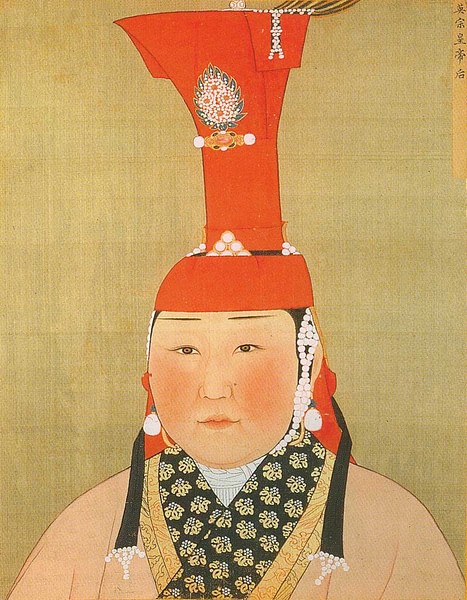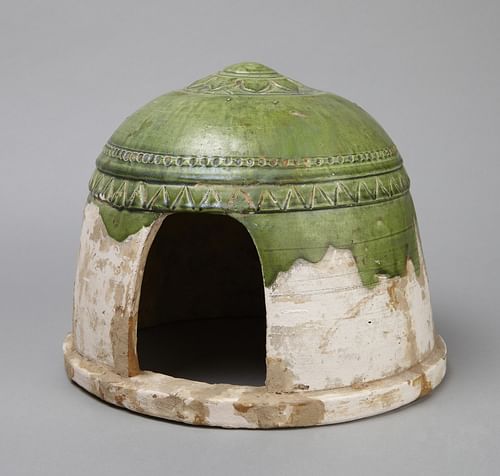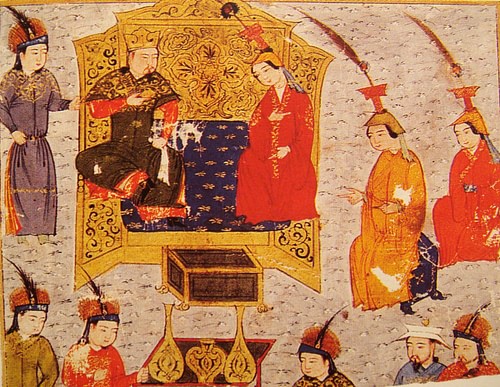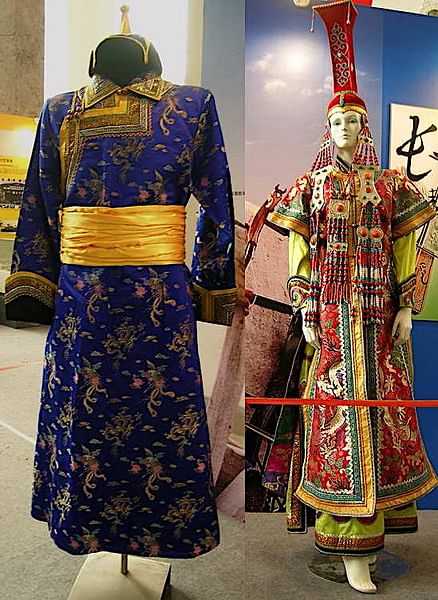what happen to the children of gingus cons concubins?
Women in the Mongol Empire (1206-1368 CE) shared the daily chores and hardships of steppe life with men and were largely responsible for tending animals, setting upwards camps, childrearing, producing food and cooking it. Having rather more rights than in contemporary cultures to the east and west of Mongolia, women could own and inherit property, were involved in religious ceremonies and could be shamans, and the wives of senior tribal leaders could voice their opinions at tribal meetings. Several Mongol women, the widows or mothers of Great Khans, even reigned as regents in the period before a new khan was elected every bit ruler of the Mongol Empire, often a span of several years.

Wife of Yuan Emperor Yingzong
Setting upward Camp
Every bit the Mongols were a nomadic people, everyone - men, women, and young children - had to be able to ride well and employ a bow for hunting. In the aforementioned vein, men and women were usually capable of doing each other's tasks since if one died, the survivor in the partnership had to behave on and wait subsequently the family and its herds. Women were responsible for both setting up and packing up camps, putting the yurt tents and the family's belongings onto the carts, which they usually drove, and packing any pack animals like horses and camels.
As experienced camp masters, women were an of import element of the logistics so vital to Mongol warfare.
There was a dedicated infinite within the yurt for men and women, the former having the due west side and the latter the due east side where the cooking was washed (hands defined since the doorway was traditionally made to face the s). The positioning of the yurts themselves in a camp (ordu) was important in imperial and larger camps with the senior wife having the tent nearest to the west, the most inferior married woman to the e, and the concubines, children, and servants someway behind.
As experienced military camp masters, women were an of import element of the logistics then vital to Mongol warfare with its fast, light cavalry units. They followed behind the master forces with the much slower wagon trains of supplies and horses, when often a single woman collection a train of several continued wagons.

Mongolian Yurt
Daily Chores
Mongol women tended animals, collected food, cooked and processed it while men hunted. Women made cheese, butter, and dried the milk curds, and also had to look after the herds while the men were away hunting which could be several weeks at a fourth dimension. Women milked the sheep, goats, and cows while simply men milked mares and produced the alcoholic beverages that were so popular. Women were involved in the laborious churning of milk in large leather numberless using a wooden paddle, a process that took several hours and eventually made the mildly alcoholic kumis drink all the same drunk today. At to the lowest degree women could also enjoy the fruit of their labours as drinking to excess by both men and women seems to have been a social norm without any stigma attached to it (even having a certain honour). Neither were women excluded from the rare feasts when nomads got together in one place such as a meeting of tribal chiefs to elect a new leader or to celebrate important birthdays, weddings and then on.
A WiFe received a small portion of her husband's belongings, which she managed but then handed on to the youngest son later his male parent's death.
Marriage & Family
Traditionally, Mongol marriages had the aim of cementing association relationships and strengthening alliances. Indeed, it was the custom to marry outside i'south clan grouping (exogamy) and at that place was a custom of abducting women from rival tribes as a ways to strengthen i clan group and weaken the other. Most marriages, though, would accept been designed to reinforce existing bonds between family groups.
Men paid a bride cost to their futurity male parent-in-law or offered labour as an alternative. As many nomadic men were relatively poor, information technology was a common custom merely to steal a wife during a raid, never heed whatever political benefits. In more genteel pre-bundled marriages, the future helpmate typically brought with her a dowry consisting of such valuables as livestock, jewellery, textile, servants, and possibly slaves. The dowry might be 'paid' over several years and was usually lower in value than the bride price paid by the groom and his family. The dowry remained the property of the married woman and was divided, on her death, amongst her children. In the always-practical life of the nomads, sometimes a double marriage might be arranged between 2 family groups, each one providing a groom and bride then the necessity of a bride price from each was avoided. Wives received a small-scale portion of their husband'due south property, which they managed but then handed on to the youngest son after his begetter's death.

Tolui & Sorghaghtani
Women looked subsequently the children and seem to take played an active role in family-decision making, with such sources as the 13th-century CE The Hole-and-corner History of the Mongols mentioning the wives of rulers making speeches to enthuse warriors and promote loyalty to their husbands. One way to promote loyalty was hospitality - entertaining the husband'south family unit, allies, and any visitors - and this was the responsibility of the wife. If a husband predeceased his wife, she might be 'adopted' by a junior male relative of his. According to Mongol laws, women could divorce and ain their own holding but merely how oftentimes this was the example in exercise is not known. In cases of infidelity, both the man and woman were executed.
Mongol society was patrilineal, and polygamy was common amid those men who could beget multiple wives and concubines. However, one wife was always selected as senior, and it was her children who would inherit their father's holding and/or position inside the tribe. As the youngest son usually inherited the family property, he and his wife would typically alive with his parents. Senior wives of tribal leaders who became widows oftentimes yet represented their late husband at tribal gatherings such as the kurultai which decided future rulers.
Clothing
Mongol women made felt by pounding sheep's wool. They also fabricated material from animate being skins and prepared leather. Material and habiliment were one of the of import avails of a family unit and were often given as gifts and as part of a bride'southward dowry. Men'due south and women'south habiliment was very similar, with both sexes wearing silk or cotton undergarments, trousers, thick felt or leather boots, and a conical chapeau fabricated from felt and fur with flaps for the ears and an upturned skirt at the front.
The nearly recognisable slice of outer clothing, still widely worn today, was the short robe or deel. This jumpsuit long jacket was folded over and closed on the left side of the chest (left breast doubled over the right) with a push or tie positioned just below the correct armpit. Some deel had pockets and the sleeves typically went only downward to the elbow. The outer lining of the robe was of cotton or silk and heavier versions had an additional fur or felt lining or a quilt padding. The inner lining was typically turned over a piffling to the outside of the garment at the sleeves and hem. For those who could afford information technology, the robe might have some exotic fur trim at the collar and edges. A wide leather chugalug busy with metal additions was worn, with women'southward versions being the more decorative. In wintertime a heavy coat of fur or felt was worn over the deel robe.

Mongol Habiliment of the Imperial Courtroom
Aristocracy men and women distinguished themselves by sporting a few peacock feathers in their hats. One of the few areas where women differentiated themselves from men, and and then only elite women, was the elaborate boqta headdress which had pearls and feathers decoration. I can even so come across these headdresses today when, for example, Kazakh women attend traditional festivities. While both men and women wore earrings, women also added metal, pearl, and feather decorations to their hair.
Religion
The religion practised by the Mongols included elements of shamanism and shamans could be both men (bo'eastward) or women (iduqan). Robes worn by shamans often carried symbols such as a pulsate and hobby horse, representing the guardian and protector spirit of the Mongol people. Shamans were believed capable of reading signs such as the cracks in sheep'south shoulder bones, allowing them to divine futurity events. An ability to change the weather was another shaman skill, particularly as a bringer of rain to the oft barren steppe. Shamans could help with medical problems and render a troubled spirit back to its rightful body. Women participated in other religions practised within the empire such every bit Taoism, Tibetan Buddhism, and Islam, sometimes even presiding over services. Regal women could also be generous patrons of certain religions and their institutions.
Famous Mongol Women
Alan Goa
Alan Goa (aka Alan-qo'a) was the mythical female parent of the Mongol peoples who was said to accept taught her five sons that in order to thrive they must ever stick together and support each other. To get this message across, she gave them a lesson in unity known as the Parable of the Arrows. Alan Goa gave each son an arrow and told him to break it; each son did so easily. She then presented a package of five arrows and not one son could pause them. Sadly, the descendants of Genghis Khan (r. 1206-1227 CE) would not remember this story when they broke up the Mongol Empire into various independent khanates.
Hoelun
Hoelun (aka Hoelun-Eke or Hoelun-Ujin) was the mother of Genghis Khan who fled with her son into the steppe wilderness after her hubby, the tribal leader Yisugei, was poisoned past a rival. Genghis, then called Temujin, was still simply nine or twelve years old at the time and so he could not maintain the loyalty of his male parent'due south followers. Every bit a outcome, he and his mother were abandoned on the Asian steppe, left to die. However, the outcast family unit managed to forage and live off the country as all-time they could. The Hugger-mugger History of the Mongols portrays Hoelun equally a stiff woman able to get together her children together and make a new life for themselves, her son, of form, going on to create one of the world'south greatest ever empires.
Toregene
Toregene Khatun (aka Doregene-Qatun, r. 1241-1246 CE), the former wife of the Merkit prince Qudu, reigned every bit regent after her husband Ogedei Khan'southward death in 1241 CE. She held power until a great council of Mongol leaders elected Ogedei's successor and Toregene'south son, Guyuk Khan, in 1246 CE. Toregene'southward reign is not looked on favourably by contemporary sources, only these are Chinese and so, in effect, written by the enemies or conquered subjects of the Mongols.

Coin of the Mongol Regent Toregene
Although she is credited with having cracking intelligence, shrewdness, and formidable political skills, particular criticism is made of her heavy taxation policies which included the privatisation of taxation-collecting whereby taxation collectors could keep annihilation for themselves above and beyond a pre-agreed amount for the territory nether their supervision. Revenues were increased only at the cost of corruption and an overburdening of farmers. Other criticisms included her (alleged) willingness to listen rather also much to the Muslim advisors close to her (specially a Persian slave named Fatima), and her manoeuvres to remove any obstruction to her son condign the next khan, including the unnecessary delaying of the next khan's election. Toregene also fostered diplomatic ties with various princes and gave out lavish gifts to increase the support base for her son, a process she was able to carry out thanks to her delaying tactics and taxation policies. She must have died a happy adult female, passing away in 1246 CE shortly after her son Guyuk had finally become Great Khan (r. 1246-1248 CE).
Sorghaghtani
Sorghaghtani Beki (aka Sorqoqtani, d. 1252 CE) was a Kerait princess who came to prominence as the widow of Tolui (c. 1190 - c. 1232 CE) and sister of Begtutmish Fujin, widow of Jochi, a son of Genghis Khan. Tolui was the youngest son of Genghis Khan and father of Mongke Khan (r. 1251-1259 CE) and Kublai Khan (r. 1260-1294 CE), simply he died around the age of 40; his lands in northern China and tribal position were maintained by Sorghaghtani. The princess may accept warned Batu Khan, leader of what would become the Golden Horde and the western khanate of the Mongol Empire, of the plans of Guyuk Khan, Nifty Khan at the time, to attack Batu. In the event, Guyuk died before such a entrada could get started but Batu may have shown his gratitude by endorsing Sorghaghtani'south son Mongke who was elected Guyuk's successor.
Oghul Qaimish
Oghul Qaimish (aka Oqol-Qaimish, r. 1248-1251 CE), was the wife of Guyuk Khan, and when he died in 1248 CE of poisoning, she reigned as regent. Oghul infamously dismissed, in 1250 CE, an embassy from King Louis IX of France (r. 1226-1270 CE), telling his ambassador Friar Andrew of Longjumeau that a great tribute would exist required if his nation was to avert devastation by a Mongol army. Oghul's reign had lilliputian to distinguish it, and she largely stayed in the background of politics. Her 1 notable policy was to increment taxes for the peasantry from the traditional i in every hundred animals to the unrealistic 1 in ten animals.
Oghul would concord power until 1251 CE when Mongke Khan was elected ruler. Oghul was ultimately taken prisoner, her hands stitched together with leather thongs, and then put on public trial by Mongke in December 1252 CE as he purged all parts of the land he considered loyal to the previous regime, specially the Ogedei association. At her trial, Oghul was stripped of her clothes and accused of beingness rather too involved with shamanism for the good of the state and, much worse, guilty of treason. Plant guilty, Oghul was thrown into the Kerulen River wrapped in a felt sack - a fate usually reserved for witches in Mongol justice as information technology was believed that evil cannot cross running water and may fifty-fifty be purified past it.
This article has been reviewed for accurateness, reliability and adherence to academic standards prior to publication.
mcmilloncamle2002.blogspot.com
Source: https://www.worldhistory.org/article/1466/women-in-the-mongol-empire/
0 Response to "what happen to the children of gingus cons concubins?"
Post a Comment